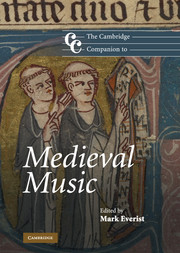Book contents
- Frontmatter
- Introduction
- Part I Repertory, styles and techniques
- Part II Topography
- Part III Themes, topics and trajectories
- 11 Music and liturgy
- 12 Vernacular poetry and music
- 13 Latin poetry and music
- 14 Compositional trajectories
- 15 Ecclesiastical foundations and secular institutions
- 16 Theory and notation
- 17 Music manuscripts
- 18 The geography of medieval music
- 19 Reception
- Notes
- Bibliography
- Index
18 - The geography of medieval music
from Part III - Themes, topics and trajectories
Published online by Cambridge University Press: 28 September 2011
- Frontmatter
- Introduction
- Part I Repertory, styles and techniques
- Part II Topography
- Part III Themes, topics and trajectories
- 11 Music and liturgy
- 12 Vernacular poetry and music
- 13 Latin poetry and music
- 14 Compositional trajectories
- 15 Ecclesiastical foundations and secular institutions
- 16 Theory and notation
- 17 Music manuscripts
- 18 The geography of medieval music
- 19 Reception
- Notes
- Bibliography
- Index
Summary
The space where medieval music happened: the Latin West
In the 1290s an Italian friar travelled through part of what is now Iraq and found a Latin missal on sale in Al-Mawsil, north of Baghdad. The book had undoubtedly been looted from a church in one of the last Crusader possessions, probably from the port city of Acre that fell in 1291. The missal was the token of a failed endeavour to carry the ritual music of the Latin West to the Holy Land and to install it there. By the time the first Crusaders took Jerusalem in 1099, a shared body of Frankish-Roman or Gregorian chant for the mass arose whether it was night or day, and regardless of the normal patterns of sleep and sustenance, from western Spain to Hungary and from Scandinavia to Sicily. The intention had been that conquests in Palestine and Syria should become part of this Latin-Christian territory forever, and when the Crusading enterprise collapsed another Franciscan complained that ‘there is only the abominable melody of Saracens where there should only be psalmody’. The muezzin and minaret had silenced the cantor and the bell tower.
The medieval music addressed in the Cambridge Companion to Medieval Music is essentially the liturgical and vocal music, both sacred and secular, of this Latin and Western civilization. It was performed in a particular geographical space and shaped by its patterns of communication, by its shifting political configurations and even perhaps by its many and varied ecologies. Figure 18.1 shows the principal territories at issue.
- Type
- Chapter
- Information
- The Cambridge Companion to Medieval Music , pp. 320 - 334Publisher: Cambridge University PressPrint publication year: 2011



